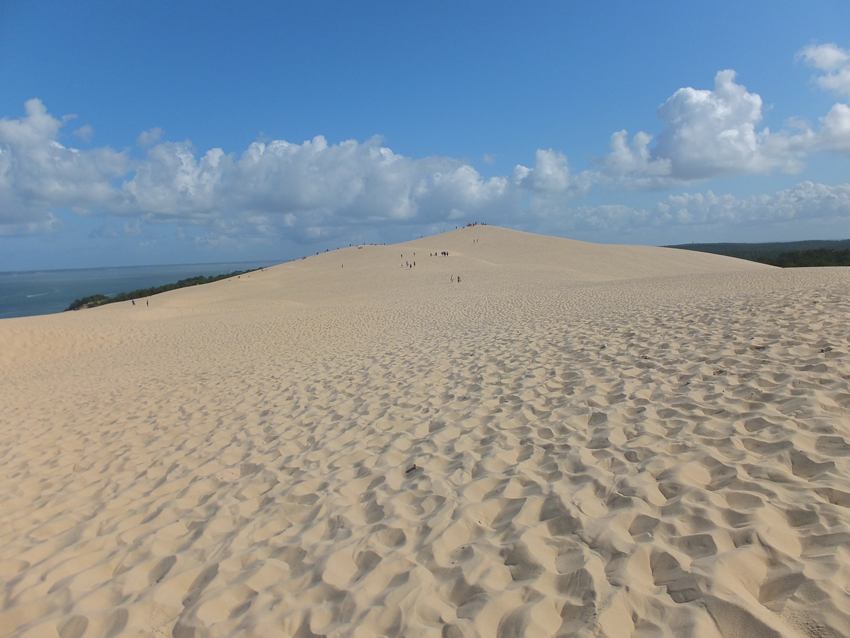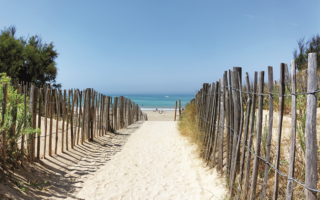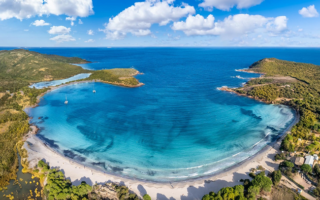France’s Sensational Sandscapes

Julie Lynn explores the beaches of the Silver Coast’ at Biscarosse, between Bordeaux and Biarritz.
It takes him a few attempts. And then he’s got it. On a hot afternoon in late July, a paraglider manages to launch himself into the deep blue sky. There’s a robust Easterly and the man’s companion succeeds in expertly handling his own harness and canopy so that he himself takes off from the actual beach rather than needing a quick scramble up the nearest dune.
The sand dunes are, of course, what this particular corner of south west France are all about. Geologically speaking. The Aquitaine beaches found between the busy main strip of Biscarosse Plage and the spectacular Dune du Pilat include those at Vivier, Lagune and Le Petit Nice. At the latter of those beaches, even in the height of summer, we pretty much have the place to ourselves. And a few paragliders. The section of beach closest to where one descends from the car park grows busy, though that’s true of all beaches from Camber to Bamburgh and beyond. But walk for five minutes and you leave the pack behind. What you have then are vast stretches of fine, pale sand.
And they are fine too. Don’t come here if what you like are pebbles, or shingle, or a little rasping coarseness to your sand. This is not for you. This place is strictly for those who crave sand, who love sand, those who by instinct fall to their knees and roll themselves in it; most of all, it’s for people who like their sand to be the consistency of the stuff that falls through the egg timer. You have time for sand like that.
The pine-edged dunes that form the backdrop to these beaches are also of this soft, dry sand, though further along the shore to the left of Le Petit Nice and towards Lagune, the pale stuff gets washed fairly high up the dunes. Which is why careful protection of them is evident. There are fenced off sections of newly planted grasses, there are wooden walkways and there are signs declaring it interdit’ to climb the dunes. The authorities appear to be reasonably relaxed about young children and paragliders, but just occasionally there is an announcement on the public address system about erosion of the dunes. But not often. If the French exhibit their natural insouciance to rules about dogs (not allowed – but there are a couple visible in the busier area), then they are on the whole happy to respect the conservation strategy in place to guard the natural beauty of their coastline. Beach life is, it has to be said, largely on the beaches rather than in the dunes.
Visible from the beach is a long and almost empty sandbank. It is accessible only to those with boats, jet skis or perhaps those with what it takes to exert themselves for quite a long time in what can be rough waters. In truth, it’s not for swimming. There are breakers all around the bank, and the swell and pull is plain. There are rocky stretches of darker water where there are no bathers, but there are just as many where having a dip is safe if not venturing out too far. There was a lively movement of the waves when we were there, but the water temperature was still an enticing 20 degrees.

A dune to remember
A short drive along the coast from Le Petit Nice is the immense Dune du Pilat, which stretches a couple of miles south of the inlet to the Bassin d’Arcachon. The largest sand dune in Europe, its dimensions are impressive. At two miles long, 375ft high and 1625ft wide, it is bound to be visually arresting. Because it is colossal. And for the aforementioned sand lovers, it is a natural sculpture of simple and mighty beauty. On the approach from Biscarosse or from Arcachon, you glimpse it fleetingly behind the tall thickets of Les Landes forests, you suddenly catch sight of a creamy, towering wall. The cost of parking a car is 4 euros for three hours and 6 euros for a day, but once you’re past the kiosks selling all the usual, there it is, the place where you start your ascent. It rises steeply here so there is a wooden walkway for those who need to break their calves in gently to sand-trekking. Otherwise, there’s the sandy option. Climbers remove footwear, stand still for a few moments as they sink into the fine, warm grains and start to take their first photos, in this particular place, of the vast canopy of the surrounding man-made forests.
The earlier the better for visiting Le Dune. It was just before 10 o’clock when we reached the top of the first part and there was only a modest amount of fellow travellers. And many of these don’t trek the two miles of empty, undulating whiteness anyway, choosing to stay fairly close to base. Later in the day, of course, la foule is in full swing, at least in the part of the Dune not too far from the kiosks, but that is about sunbathing somewhere nice rather than going on too much of a hike.
The Dune is enthralling. It is a symphony of sand. Time and again you click onto Panoramic’ and take photos with nobody straying into the frame, you capture images just of smooth stretches into the distance of sunlit cream. Or rather cream (sands), blue (sky and sea) and bottle green (forest). It’s the forest side that is steep. At one point, we watch a mother with a small child struggling up the 40 degree slope they’ve taken from the campsite. Should we risk personal calamity to help? But she does not appear overly concerned and the figure at the top watching her is perhaps her husband. At that point, others seem to start towards her in a rescue bid, though suddenly they all veer quickly and laughingly to the side of her instead, beginning to trot and tumble at a rapidly gathering pace. So we look away.
Where we look is to the sea, to the other side of the Dune. That’s where the slope falls away gently rather than with drama and that’s where any sand-tumbling rapture is of a more risk-calculated kind. The views here are truly magnificent. Along the largely straight shoreline there’s the odd shallow curve of bay to both left and right, out to sea straight ahead is the swirling sandbank d’Argun and to the right, in the distance, is Cap Ferret with its three lighthouses. In the autumn the Dune is a serious vantage point for seeing migratory birds en route to the sanctuary at Le Teich, an ornithological site to the north.

This Landes is your Landes
There is much to recommend this corner of south west France apart from the quiet, elegance of its silvery, pale sands (It’s not called the Cote d’Argent for nothing). Cycling, for instance. The vast, artificial forests of Les Landes were created in the 19th century on an area of sand and marsh, with pines and grasses being introduced in order to anchor the dunes and give stability to their constant shift and taking to the pedals is an idea way of discovering more of the Parc Naturel Regional des Landes de Gascogne, where there are various routes for those hiring bikes. Other options are the trails for walkers, taking to horseback or even the treetops (la grimpe aux arbres). Or even taking to the sleepy rivers in a canoe for exploring the staging posts along the Pilgrim’s Way to Compostella. But if it’s hot and you need a swim that doesn’t necessarily involve whole worlds of sand, and sea bathing, then there are always the nearby inland freshwater lakes. These etangs, which are also popular for fishing and boating, are situated at Biscarosse and Sanguinet. They’re only a short drive by car from the coast. Though probably a little further by `le parapente’.
Share to: Facebook Twitter LinkedIn Email
Leave a reply
Your email address will not be published. Required fields are marked *



